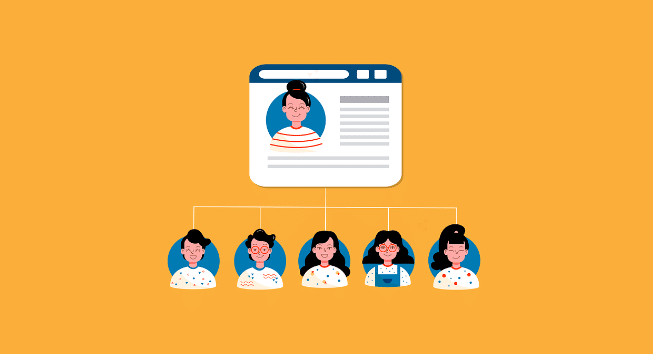
A buyer persona is a semi-fictional representation of a company’s ideal customer. It is important for businesses to define their buyer persona because it helps them identify their target audience and tailor their products and services to meet the needs of that audience. By understanding the demographics, interests, motivations, and challenges of a buyer persona, companies can create content and campaigns that effectively reach and influence their target customers. In addition, having a clearly defined buyer persona can help businesses narrow their focus and develop a more effective marketing strategy. By understanding who they are trying to target and what they want, businesses can create a better customer experience and maximize their return on investment.

100% FREE REPORT!
"Get Instant Access To My Top 10 Coaching Resources To Kick-Start Your Coaching Business"
Simply enter your email below so we know where to send it...
What is a Buyer Persona and Why Is It Important?
A buyer persona is a semi-fictional representation of a company’s ideal customer. It is important for businesses to define their buyer persona because it helps them identify their target audience and tailor their products and services to meet the needs of that audience. By understanding the demographics, interests, motivations, and challenges of a buyer persona, companies can create content and campaigns that effectively reach and influence their target customers. In addition, having a clearly defined buyer persona can help businesses narrow their focus and develop a more effective marketing strategy. By understanding who they are trying to target and what they want, businesses can create a better customer experience and maximize their return on investment.
Benefits of Having a Buyer Persona
Having a buyer persona helps businesses understand their target customers and create content and campaigns that are more likely to be successful. Having a clear understanding of the characteristics of their ideal customer can help businesses create more effective marketing strategies and campaigns. Additionally, businesses can use buyer personas to optimize their customer experience, as they can create a customer journey that resonates with their target customer. Furthermore, having a buyer persona can also help businesses prioritize their resources and focus their efforts on the areas that will be most effective.
Another benefit of having a buyer persona is that it helps businesses increase their return on investment. By understanding the needs and interests of their target customer, businesses can create content and campaigns that are more likely to result in sales. Additionally, having a buyer persona can help businesses identify other potential customers who have similar characteristics. By understanding the needs and interests of these customers, businesses can create more effective marketing strategies and campaigns that can lead to increased sales.
How to Create a Buyer Persona
Creating a buyer persona is not a difficult process, although it does require some research. The first step is to gather information about your target customer. This can include demographic information such as age, gender, location, and income level. Additionally, you should also identify the customer’s needs, interests, and motivations. Finally, you should look at their challenges and how they make buying decisions.
Once you have gathered this information, you should create a profile of your ideal customer. This profile should include the customer’s name, age, gender, location, and income level. Additionally, it should include their interests, motivations, and challenges. Once you have created this profile, you should create a list of questions that you can use to further refine your buyer persona.
Types of Buyer Personas
There are several types of buyer personas, including primary and secondary personas. Primary personas are the main target of your campaigns, while secondary personas are those who may be interested in your products and services but are not necessarily your primary target. Additionally, there are also customer segmentation personas, which are created based on different customer segments such as age, gender, location, and income level. Finally, there are also lifestyle personas, which are created based on different lifestyles such as professional, family-oriented, and budget-minded.
Examples of Buyer Personas
One example of a buyer persona is the general family man. This persona is typically a married man in his mid to late 30s who has a family. He is a professional who has a college degree and works in a white-collar job. He has a moderate income and is interested in products and services that can help him save time and money. He is also looking for products and services that can help him provide for his family.
Another example of a buyer persona is the budget-minded shopper. This persona is typically a single woman in her mid to late 20s who is looking for ways to save money. She is likely to be interested in products and services that offer discounts and deals. She is also likely to be interested in products and services that can help her save time and money.
Finally, another example of a buyer persona is the tech-savvy professional. This persona is typically a single man in his late 20s to early 40s who is interested in the latest technologies. He is likely to be interested in products and services that can help him stay up to date with the latest trends. He is also likely to be interested in products and services that can help him stay ahead of the competition.
How to Use Buyer Personas in Marketing Strategies
Once you have created your buyer personas, you can use them to create targeted campaigns and content that resonates with your target customers. You can use your buyer personas to create targeted content that speaks to the needs and interests of your target customers. Additionally, you can use your buyer personas to create targeted campaigns that are more likely to result in sales.
You can also use your buyer personas to optimize your customer experience. By understanding the needs and interests of your target customers, you can create a customer journey that meets their needs. You can use your buyer personas to identify areas where you can improve your customer experience, as well as areas where you can add value. Additionally, you can use your buyer personas to create personalized offers and promotions that are more likely to be successful.
How to Measure the Success of Buyer Personas
Once you have created your buyer personas, it is important to measure their success. One way to measure the success of your buyer personas is to look at the results of your campaigns. You can look at the number of conversions and the average purchase size to see if your campaigns are successful. Additionally, you can look at the feedback from your customers to see if your campaigns are resonating with them. Finally, you can use analytics tools to track the performance of your campaigns and see how your buyer personas are performing.
Common Mistakes Companies Make When Creating Buyer Personas
Creating buyer personas can be a complex process, and there are several common mistakes companies make when creating buyer personas. One of the most common mistakes is not gathering enough information. It is important to gather as much information as possible about your target customers so that you can create an accurate and detailed buyer persona.
Another common mistake companies make is not creating enough buyer personas. It is important to create multiple buyer personas to make sure that you are targeting all of your potential customers. Additionally, it is important to create buyer personas that are based on different customer segments. This will help you make sure that your campaigns and content are reaching all of your potential customers.
Finally, another common mistake companies make is not updating their buyer personas. It is important to regularly update your buyer personas to make sure that they are accurate and up to date. Additionally, it is important to review the performance of your campaigns and content to make sure that they are resonating with your target customers.
Tips for Creating an Effective Buyer Persona
Creating an effective buyer persona is not a difficult process, but there are several tips that can help you create an effective persona.
First, it is important to gather as much information as possible about your target customer. This includes demographic information such as age, gender, location, and income level. Additionally, it is important to identify their needs, interests, and motivations. Finally, it is important to look at their challenges and how they make buying decisions.
Second, it is important to create multiple buyer personas. This will help you make sure that you are targeting all of your potential customers. Additionally, it is important to create buyer personas that are based on different customer segments. This will help you make sure that your campaigns and content are reaching all of your potential customers.
Third, it is important to regularly update your buyer personas. This will help you make sure that they are accurate and up to date. Additionally, it is important to review the performance of your campaigns and content to make sure that they are resonating with your target customers.
Finally, it is important to measure the success of your buyer personas. You can use analytics tools to track the performance of your campaigns and see how your buyer personas are performing. Additionally, you can look at the results of your campaigns and the feedback from your customers to see if your campaigns are successful.
Conclusion
In conclusion, it is important for businesses to define their buyer persona because it helps them identify their target audience and tailor their products and services to meet the needs of that audience. By understanding the demographics, interests, motivations, and challenges of a buyer persona, companies can create content and campaigns that effectively reach and influence their target customers. Additionally, having a clearly defined buyer persona can help businesses narrow their focus and develop a more effective marketing strategy. By understanding who they are trying to target and what they want, businesses can create a better customer experience and maximize their return on investment.